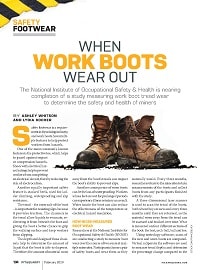Mining Publication: When Work Boots Wear Out
Original creation date: February 2019
Authors: A Whitson, L Kocher
Safety footwear is a requirement in the mining industry, and work boots have multiple features to help protect workers from hazards.
One of the most commonly known features is the protective toe, which helps to guard against impact or compression hazards. Shoes with electrical hazard ratings help to prevent workers from completing an electrical circuit, thereby reducing the risk of electrocution.
Another equally important safety feature is stacked heels, used for ladder climbing, waterproofing and slip resistance.
The tread – the outer sole of the boot – is important for resisting slips because it provides traction. The channels in the tread allow liquids to evacuate, redirecting it from beneath the foot and giving the boot a better chance to grip the walking surface and keep workers from slipping.
The depth and design of those channels help to determine the amount of liquid that the boot is able to disperse. Therefore, the amount of material worn away from the boot’s treads can impact the boot’s ability to prevent slips.
Another consequence of worn boots can be the loss of waterproofing. Workers whose feet are wet for prolonged periods can experience illness or injury as a result. Water inside the boot can also reduce the effectiveness of the temperature or electrical hazard insulation.

- Contributing Factors to Slip, Trip, and Fall Fatalities at Surface Coal and Metal/Nonmetal Mines
- The Effect of Cap Lamp Lighting on Postural Control and Stability
- Effects of Metatarsal Work Boots on Gait During Level and Inclined Walking
- Infographic: Inspect Your Boots for Signs of Wear
- Investigation of a Slip/Fall Accident
- Method for Measuring Wear on Boot Outsoles Using a 3D Laser Scanner
- Preventing Slips, Trips and Falls from Front-end Loaders
- Slip Potential for Commonly Used Inclined Grated Metal Walkways
- Slip, Trip, and Fall Hazard Identification, Investigation, and Remediation at Surface Mining Facilities
- Visual Performance for Trip Hazard Detection When Using Incandescent and LED Miner Cap Lamps